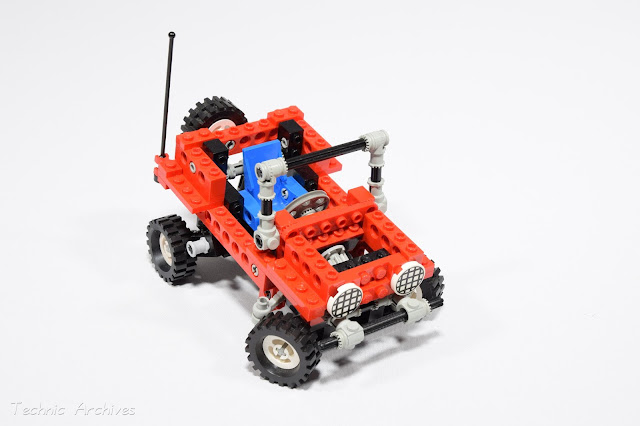Offroaders are popular theme in Technic. While the 8820 was not the first off-road car, but it was the first off-roader to employ the compact steering element.
When I was a kid, I was looking so much at the image of this car in the catalogue, that I have false memories of playing with it. Though I have never had it.
Set number: 8820
Year released: 1991
Set name: Mountain Rambler
Number of pieces: 139
Building and functions
The main attraction of the vehicle is the spring element attached to a rear swingarm. I might add, that the sprung suspension element were not new in this set, it was first released in 1980, in the set 8860: the second supercar!The wheels themselves are not attached to same axle to which the suspension element is connected, but are sitting on their own axle-pin. The car drives rather smooth because of it: while taking a corner, the real wheels do not slip, as they are turning individually. Unlike it’s descendant, the 8816, the rear wheels cannot move individually, they are sharing a single swingarm and there is only one suspension element included.
The building instruction are short, like they were in the 90ies, but because the set consists of only a handful of pieces, the steps are easy to follow. The model relies mostly on a studded construction, but there are a few pins as well.
Motorising
The building instructions contains detailed, step-by-step instructions to add a 9V electric motor to the B model, using the 8720 supplemental set. There are no instruction to motorize the A model, probably because there is no insufficient space behind the seat.The motor drives the back axle. The building instructions offers no solution to motorise the steering.
Play value
Attention to detail is quite good: I liked the opaque black antennae, which I have never seen before in this colour. I have only had transparent neon green ones, probably from a space set. The fold down windshield is quite handy, as it makes it easy to reach the steering wheel. There is also a spare wheel at the back of the car.After building the set, I had the opportunity to see the incredible problem solving skill of kids, in motion: I showed to my 3 years old son, that my fingers are too big to comfortably hold the steering wheel, and it’s a pity, that this model does not have a “Hand of God” steering (like the car from the set 8024 has). He found the perfect solution in an instant, as he started to turn the spare wheel. It’s an opportunity well missed, as it would have made a nice aesthetic element into a functional one as well. But then again it would have been hard to thread an axle through under the car.
B model
The second half of the building instructions contains a dune buggy, with a wheelbase a half stud longer than the A model. The suspension element holds the roll cage, instead of the real axle. This has no real practical value, but the model looks rather nice in my opinion:the forward leaning body, the spoiler at the rear, the floodlights fastened to the roll cage makes a nice looking car.
Impressions
When I was a kid, I had my eyes on this car, not because it fascinated me, but mostly because it is a small set, probably wasn’t expensive, and I was hoping that maybe I could get it as a birthday present. But most of all, because if combined with a go-cart (8815) and a multi-model set (8024) a race car can be built from it. I thought it was something like a ‘poor man’s supercar’, not as awesome as the 8865 ‘Test Car’, which was the flagship set back then, but still a little bit super. An almost affordable supercar.
Rare Parts
This set contains the toothed axle-pin connector which really likes to break, and the old style, toothed half-bush. Even worse, you can’t replace the half-bush elements with the newer, smooth ones, because the toothed side is employed during the build in both models. And also the more common axle-pin connector, which is prone to break too, and sometimes even full size bush elements do as well.











Comments
Post a Comment